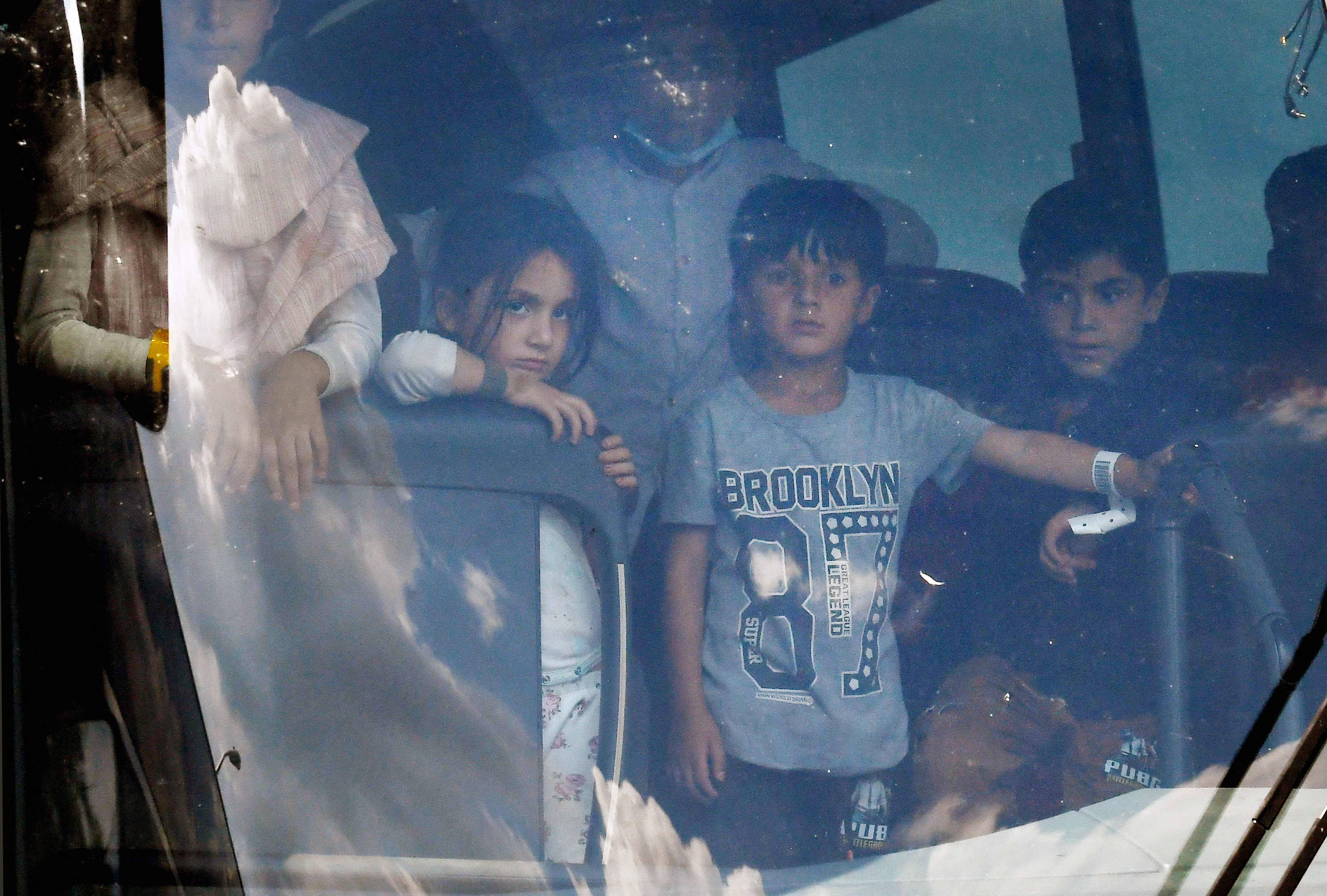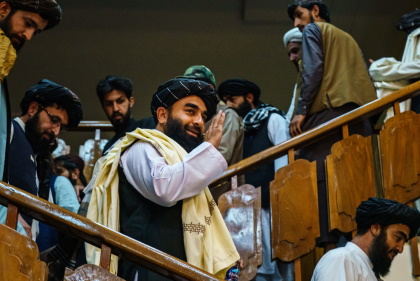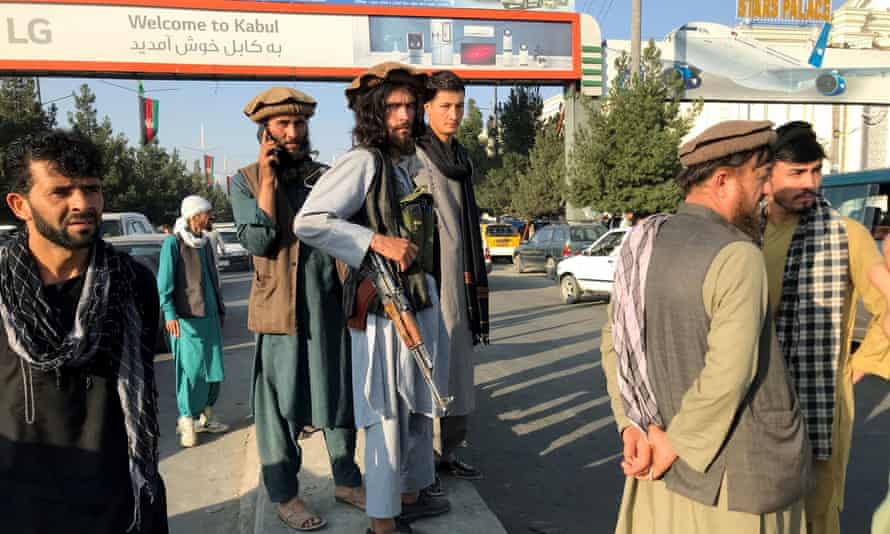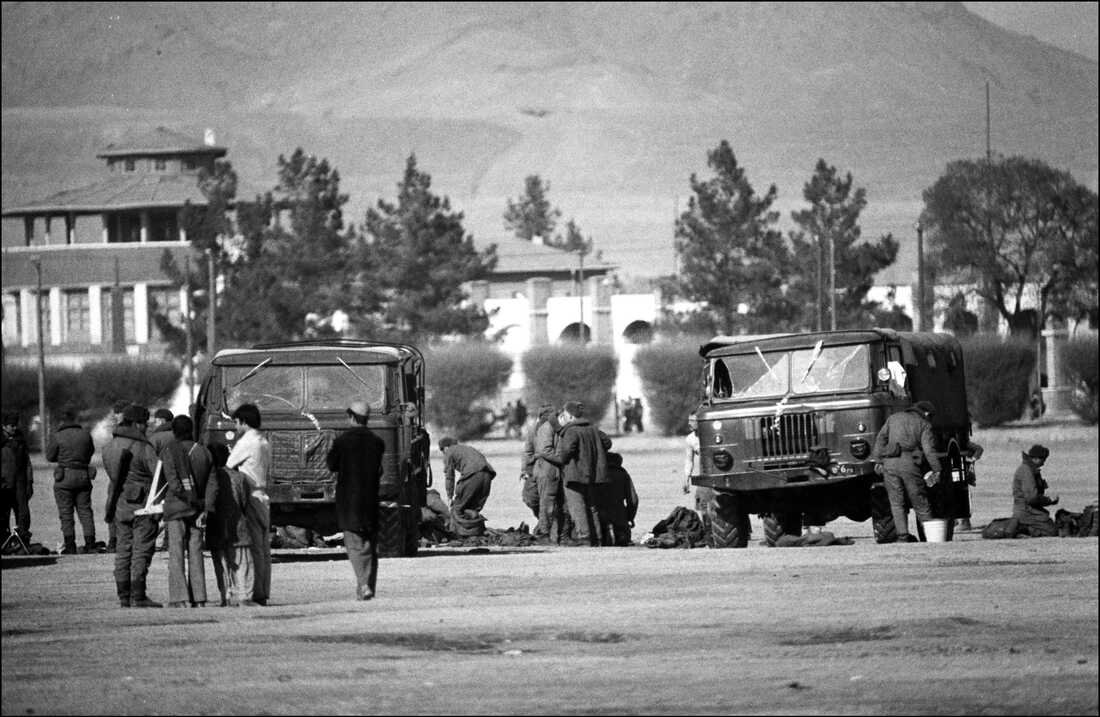The Soviet army in Kabul, Afghanistan, on Dec. 31, 1979.
The collapse of the Afghan government and the Taliban's recapture of power came after a blitz by the militant group that stunned many Afghans and the world. It is the latest chapter in the country's nearly 42 years of instability and bitter conflict.
Afghans have lived through foreign invasions, civil war, insurgency and a previous period of oppressive Taliban rule. Here are some key events and dates from the past four decades.
The Soviet war years
December 1979
Following upheaval after a 1978 Afghan coup, the Soviet military invades Afghanistan to prop up a pro-Soviet government.
1980
Babrak Karmal is installed as Afghanistan's Soviet-backed ruler. Groups of guerrilla fighters known as mujahideen or holy warriors mount opposition and a jihad against Soviet forces. The ensuing war leaves about 1 million Afghan civilians and some 15,000 Soviet soldiers dead.
Millions of Afghans begin fleeing to neighboring Pakistan as refugees. The U.S., which had previously been aiding Afghan mujahideen groups, and Saudi Arabia covertly funnel arms to the mujahideen via Pakistan through the 1980s.
Afghan refugees are shown in a camp on Kohat Road outside of Peshawar, Pakistan, in 1980.
1983
President Ronald Reagan welcomes Afghan fighters to the White House in 1983, and mujahideen leader Yunus Khalis visits the Oval Office in 1987.
Former President Ronald Reagan meets in the Oval Office in 1983 with Afghan fighters opposing the Soviet Union.
1986
The CIA supplies Stinger antiaircraft missiles to the mujahideen, allowing them to shoot down Soviet helicopter gunships.
An Afghan guerrilla handles a U.S.-made Stinger anti-aircraft missile.
1987
Mohammad Najibullah, groomed by the Soviets, replaces Karmal as president.
1988
The Geneva peace accords are signed by Afghanistan, the Soviet Union, the U.S. and Pakistan, and Soviet forces begin their withdrawal.
Feb. 15, 1989
The last Soviet to leave Afghanistan, Lt. Gen. Boris Gromov, walks with his son Maxin on the bridge linking Afghanistan to Uzbekistan over the Amu Darya River. The Soviet commander crossed from the Afghan town of Khairaton.
The last Soviet soldier leaves Afghanistan.
The 1990s to 2001: Civil war followed by Taliban rule
1992
Following the withdrawal of Soviet forces and the collapse of the Soviet Union in 1991, Najibullah's pro-communist government crumbles. He is blocked from leaving Afghanistan and takes refuge at the Kabul United Nations compound, where he remains for more than four years.
Mujahideen leaders enter the capital and turn on each other. Refugees continue to flee in huge numbers to Pakistan and Iran.
The presidential palace in Kabul is severely damaged after being hit by tank shells and rockets fired by Gulbuddin Hekmatyar's Hezb-e-Islami fighters.
Kabul, largely spared during the Soviet war, comes under brutal attack by forces loyal to mujahideen leader Gulbuddin Hekmatyar. Much of the city is left in rubble. The national museum is rocketed and looted. Some 50,000 people are killed.
1994
The Taliban, ultraconservative Afghan student-warriors emerging from mujahideen groups and religious seminaries in Pakistan and Afghanistan, take over the southern Afghan city of Kandahar, promising to restore order and bring greater security. They quickly impose their harsh interpretation of Islam on the territory they control.
A Taliban fighter guards a road southeast of Kabul in 1995.
May 1996
Saudi-born al-Qaida leader Osama bin Laden arrives in Afghanistan after being expelled from Sudan, and eventually ingratiates himself with the one-eyed Taliban supreme leader, Mullah Mohammad Omar. Bin Laden had previously aided Afghan mujahideen forces during the Soviet war years as one of many so-called "Afghan Arabs" who joined the anti-Soviet fight.
Osama bin Laden speaks at a press conference in Khost, Afghanistan, in 1998.
Sept. 26, 1996
The Taliban take over Kabul. They capture Najibullah, the former president, from the U.N. compound, kill him and hang his body from a lamppost.
Taliban rally in Kabul, October 1996.
1997-1998
Gaining control over most of the country, the Taliban impose their rule, forbidding most women from working, banning girls from education and carrying out punishments including beatings, amputations and public executions. Only three countries officially recognize the Taliban regime: Pakistan, Saudi Arabia and the United Arab Emirates.
In August 1998, the U.S. launches cruise missile strikes on Khost, Afghanistan, in retaliation for al-Qaida attacks on U.S. embassies in Kenya and Tanzania.
Afghan women wear Taliban-imposed burqas in Kabul.
1999
The U.N. Security Council imposes terrorist sanctions on the Taliban and al-Qaida.
In December, an Indian Airlines passenger jet, bound from Kathmandu to New Delhi, is hijacked to Kandahar. The Taliban serve as mediators between the hijackers and Indian authorities, who decide to free three terrorists from Indian prisons and hand them over to the hijackers in exchange for the passengers' safety.
March 2001
Rejecting international pleas, the Taliban blow up two 1,500-year-old colossal Buddha statues carved into a mountainside in Bamiyan, saying the statues were "idols" prohibited under Islam.
Afghan Taliban in front of the empty niche that held one of the two giant Buddha statues the Taliban blew up in Bamiyan in March 2001.
August 2001
The Taliban put a group of Western aid workers on trial, accusing them of preaching Christianity, a capital offense. Two American women are among the accused.
September 2001
Anti-Taliban Northern Alliance leader Ahmad Shah Massoud is assassinated on Sept. 9 by al-Qaida operatives posing as TV journalists.
After al-Qaida's Sept. 11 attacks in New York City and Washington, the U.S. demands that the Taliban hand over bin Laden. They refuse.
The U.S.-led invasion
Oct. 7, 2001
An undated file photo shows a U.S. Air Force B-52 Stratofortress heavy bomber. The U.S.-led coalition launched air and missile strikes in Afghanistan on Oct. 7, 2001.
A U.S.-led coalition launches Operation Enduring Freedom, targeting the Taliban and al-Qaida with military strikes.
November-December 2001
The U.S.-backed Northern Alliance enters Kabul on Nov. 13. The Taliban flee south and their regime is overthrown. In December, Hamid Karzai is named interim president after Afghan groups sign the Bonn Agreement on an interim government. Under that agreement, some warlords are named provincial governors, military commanders and cabinet ministers, as are members of the Northern Alliance. The NATO-led International Security Assistance Force is established under a U.N. mandate.
2003
Defense Secretary Donald Rumsfeld signals an end to "major combat activity" in Afghanistan, saying, "We clearly have moved from major combat activity to a period of stability and stabilization and reconstruction and activities."
2004
Afghanistan holds a presidential election, won by Hamid Karzai.
2005
Afghanistan's parliament opens after elections bring in lawmakers including old warlords and faction leaders.
The Taliban reemerge
2006
The Taliban seize territory in southern Afghanistan. NATO's ISAF assumes command from the U.S. in the south, something the NATO secretary general calls "one of the most challenging tasks NATO has ever taken on."
2009
Karzai is reelected president.
The U.S. "surge" begins after President Barack Obama orders substantial troop increases in Afghanistan. Obama says that U.S. forces will leave by 2011.
2012
NATO announces it will withdraw foreign combat troops and transfer control of security operations to Afghan forces by the end of 2014.
2013
The Afghan army takes on security operations from NATO forces.
The Obama administration announces plans to start formal peace talks with the Taliban.
2014
After a disputed election, Ashraf Ghani succeeds Karzai as Afghanistan's president. Ghani's rival, Abdullah Abdullah, is named chief executive.
A U.S. soldier walks past burning trucks at the scene of a suicide attack in Afghanistan's Nangarhar province in 2014.
At the end of the year, U.S. and NATO forces formally end their combat missions.
2015
NATO launches its Resolute Support mission to aid Afghan forces. Heavy violence continues as the Taliban step up their attacks on Afghan and U.S. forces and civilians, and take over more territory. At the same time, an Afghan ISIS branch also emerges.
Taliban members and Afghan officials meet informally in Qatar and agree to continue peace talks.
The Taliban make publicly known that Mullah Omar, the group's founder, died years earlier. Mullah Akhtar Mansour is named as the new leader. He is killed the following year in a U.S. drone attack in Pakistan.
2016
The Afghan government grants immunity to former mujahideen leader Gulbuddin Hekmatyar, known in the civil war years as the "butcher of Kabul."
2017
Fighting continues between government forces and the Taliban, and attacks attributed to the Taliban and ISIS convulse the country.
The U.S. endgame
2018
President Donald Trump appoints former U.S. Ambassador to Afghanistan Zalmay Khalilzad as his special representative to negotiate with the Taliban.
2020
After another disputed election in 2019, Ghani is declared president and Abdullah as head of the government's peace negotiating committee in early 2020.
Violence increases in Kabul. ISIS claims responsibility for some attacks, while others are never claimed. Journalists and rights activists are assassinated. Other targets include a maternity hospital and a girls' school.
U.S. Special Representative for Afghanistan Reconciliation Zalmay Khalilzad and Taliban co-founder Mullah Abdul Ghani Baradar shake hands after signing the U.S.-Taliban peace agreement in Doha, Qatar, on Feb. 29, 2020.
The U.S. and the Taliban sign a peace agreement in Doha, Qatar, on Feb. 29. The two sides agree on terms including for the U.S. withdrawal of troops and the Taliban to stop attacks on Americans.
Direct Taliban-Afghan government negotiations begin in Doha in September, but quickly stall and never resume in a serious way.
April 14, 2021
President Biden announces the withdrawal of remaining U.S. troops by Sept. 11.
President Joe Biden walks through Arlington National Cemetery in April to honor fallen veterans of the Afghan conflict.
May 2021
The Taliban begin gaining territory in the north.
July 2021
An Afghan National Army soldier stands on a Humvee at Bagram Air Base after all U.S. and NATO troops left, in July.
U.S. troops leave the Bagram Airfield, the key hub for the American war.
August 2021
The Taliban seize control of key cities and provinces, often without a fight. Within days, the only major city not under their control is Kabul.
Ghani flees, the government collapses and the capital comes under Taliban control on Aug. 15. Chaos erupts at the Kabul airport as desperate Afghans try to leave the country and a new era of painful uncertainty begins.
At a press conference on Aug. 17, Taliban spokesman Zabihullah Mujahid promises an inclusive government, security for aid agencies and embassies and women's rights to work and go to school — within his group's interpretation of sharia law.
Taliban fighters take control of Afghanistan's presidential palace after President Ashraf Ghani fled the country on Sunday.



























